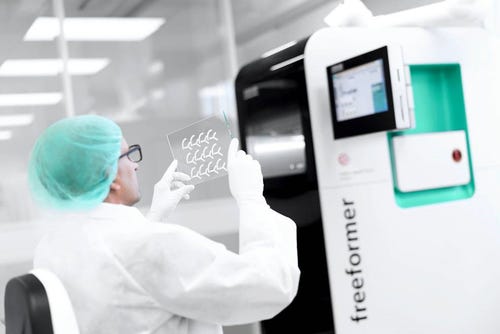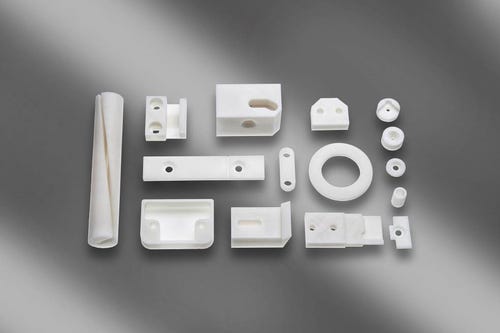Advances in Materials and Processing Improve 3DP Results
Removing material constraints and improving post-processing has opened up new possibilities for additive manufacturing.
April 21, 2023

In recent years, 3D printing as a manufacturing process has advanced at a remarkable rate. The changes in the acceptance of 3DP can be traced to improvements in materials and post-processing technology. For decades, these two areas have stymied the growth and potential of additive manufacturing. As these limitations lifted, the use of 3DP advanced quickly.
When Boeing and NASA began using 3DP parts in aerospace vehicles, the whole industrial world took notice. Maybe this technology has truly come of age. The use of custom 3DP parts in medical has been stunning. 3DP-based medical advances have improved the quality of life for patients and even saved lives.
We caught up with Fred Kaplan, an expert at the additive manufacturing company, Arburg Inc. to get his take on how new materials and improved post-processing techniques have changed the nature of 3D printing.
Design News: Seems pretty common today for companies to make one-of-a-kind or low-volume, bespoke plastic parts using additive manufacturing.
Fred Kaplan: Definitely. From the beginning, additive technology has promised the ability to make individualized complex geometries. But the introduction of production-grade open-source materials and a constantly expanding range of modalities or construction methods are bringing even more functionality and value to 3D printed parts.
DN: What’s the current state of the art here? Can you cite some examples or current applications?
Fred Kaplan: Eye-popping state-of-the-art examples are primarily in medical applications, such as implantable materials that have disrupted joint-replacement surgery and that assist in post-op bone regeneration to extend human lives. Robotic 3D printers that can build metal rocket fuselages or concrete house frames are other areas where we’re seeing incredible new state-of-the-art applications.
DN: What limitations still exist?
Fred Kaplan: Historically, the limitation of additive manufacturing has been material selection but that is improving every day. The surface quality of 3D printing has also been a limitation to the adoption of additive technology, but recent improvements in post-processing – including automated support removal, vapor smoothing, and tumbling – are creating new opportunities from old challenges. Another limitation is the inherent risk of delamination in parts created by adhering material, there is always a risk of delamination, which is inherent to the process. On the other hand, liquid 3D printing processes are generally more isotropic.
DN: You have developed the Arburg Plastic Freeforming (APF) process that has 3D printing using standard thermoplastic pellets. How is it different from other AM systems?
Fred Kaplan: Arburg’s Freeformer machine and APF technology allow part producers to use open-source production-grade materials like those used in injection molding or extrusion. This greatly expands the list of material choices beyond those available in filament form and opens up new applications. Instead of laying down rows of melted filament, the Freeformer plasticizes the thermoplastic pellets in the same kind of barrel/screw plasticating mechanism used in injection molding. Once the pellets are in a liquid state the Freeformer builds the parts with discrete spherical droplets that are approximately 200 microns in circumference; this creates very dense thermoplastic parts.
DN: What are the benefits of this process for design engineers?
Fred Kaplan: Because the process uses standard thermoplastics, it is not limited by available filament materials. This means that one-of-a-kind parts can be created with essentially the same look, feel, and performance as volume-production parts. In medical applications, for instance, 3D printing can now be used to produce patient-specific medical devices with a wider range of appearance and performance properties.
APF also can be used to print up to three materials simultaneously – combining, for instance, both durable/rigid and elastomer materials in one print for a more functional part.
DN: Is that the biggest difference between the Freeformer and filament-based AM machines?
Fred Kaplan: Almost certainly, it has to be the wide range of polymers that can be printed. I am amazed by the variety of thermoplastics that are available in pellet form. Arburg has qualified over a hundred resin grades to date and many hundred more potentially could be used.
There are medical grades of ABS, a wide variety of high-temperature materials, and, as I mention, thermoplastic elastomers as well. There are probably tens of thousands of materials that could be printed by the Freeformer and testing is ongoing to expand the range of compatible materials. There are also researchers printing pharmaceuticals and other proprietary materials and combinations of materials.
DN: Can you share an example or two of possible real-world applications?
Fred Kaplan: Samaplast, a Swiss medtech company, is using the Freeformer to 3D print implants using biocompatible materials made by Evonik & DSM. They have been able to print a multi-material meniscus using different types of polyurethane in just a few days. The company is also exploring ways to use the APF process to make spinal cages that orthopedic surgeons can implant in a patient for more than 180 days. These cages are typically Samaplast expects the APF process can open the door to personalized implants that will improve patient outcomes.


Mosca is a manufacturer of strapping machines that have over 20,000 individual components, many of which are machined from high-performance plastics. When customers require series parts in small batch sizes in a hurry, Mosca identified over 100 different components, required in small quantities (1 to 50 pieces that were too costly and time-consuming to manufacture using conventional methods. Today, the company is using the Arburg Freeformer to 3D print series parts in small batch sizes made from EMS-Grivory’s Grilamid XE 4010 Nylon 10 material. The Freeformer parts met strict requirements for strength and dimensional stability.

DN: What do you think the near-term future holds for additive technology?
Fred Kaplan: As additive technology progresses, I expect that faster and larger printers will be available at lower costs. I also think the future will see disruptive growth in medical, aerospace, and automotive -- and I’m looking forward to that future.
About the Author(s)
You May Also Like





